Still Neglected
Randee Silv
April 2017
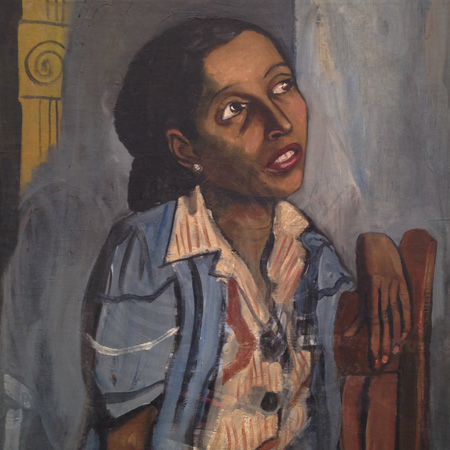 Mercedes Arroyo, 1952, close-up image courtesy of Arteidolia
Mercedes Arroyo, 1952, close-up image courtesy of Arteidolia
I immediately found myself in a crossfire of conversations. Ricocheting. Intimate. Political. Some might’ve known each other. Some maybe not. Some were absent. Circling in and out of the gallery’s multiple spaces felt like riding hypnotic waves that converged at the intersections Alice Neel had so skillfully made visible. She gave each person a platform to speak, disrupt, disturb. She made introductions. They were hard to walk away from. I wasn’t going to let them fade into the stark white walls.
Being on display in a neighborhood nothing like theirs seemed awkward, out of place. Were they put there to defend themselves? To educate people on class, race & gender inequality? To represent colors of diversity? To awaken social consciousness?
Alice Neel and José Santiago Negrón moved in 1938 from Greenwich Village up to East 107th, where they’d found a cheap railroad apartment with plenty of space and light. Anyone who would sit for her — neighbors, friends, community organizers, comrades, strangers — were her palette. She was still no less involved with left politics & issues of social justice, commitments that clearly intertwined with why and how she painted. Neel was unwilling to “cross out a group of people or to make them forever on the defensive.” She said, “East Harlem is like a battlefield of humanism, and I am on the side of the people there, and they inspire my painting.” There was rapport, full of talk back and forth, as she’d venture beyond surface appearances to reveal a person’s unseen inner core.
Neel had lived in Havana with her Cuban husband, Carlos Enríquez Gómez for a year and a half during the ’20s. Both were totally absorbed in painting, both had work exhibited and both were part of the vanguardia circle of artists, poets and writers opposed to colonialism and capitalist injustice in Latin America. “My life in Cuba had much more to do with my later psychology. It conditioned me a lot.” She also said that it was with Carlos that she had developed a “Latin mentality.”
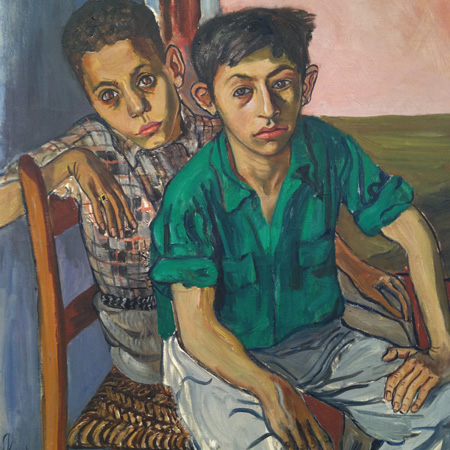 Two Puerto Rican Boys, 1956, close-up image courtesy of Arteidolia
Two Puerto Rican Boys, 1956, close-up image courtesy of Arteidolia
Neel was a member of the Artists’ Union, originally the Unemployed Artist Group started by 25 artists working for the Emergency Work Bureau. When faced with a shutdown, they sent a petition to the administration addressing economic security and state support. “The State can eliminate once and for all the unfortunate dependence of American artists upon the caprice of private patronage.” The 1933 Public Works of Art Projects was set up. When asked if she’d like to paint for $30 a week, Neel enrolled immediately. “All the artists were on the project. If there had been no such cultural projects there might well have been a revolution.”
Many in the Artists’ Union were also active in the CPUSA, which exerted influence around direction and strategies. From 1933 – 1942, the Artists’ Union pressured for work-relief programs, advocated for “professional trade union wages,” dealt with red tape and mediated grievances for artists who’d been hired by the Federal Arts Program of the Works Project Administration under Roosevelt’s New Deal. Women and artists of color were able to apply. The union fought for permanent funding. An enormous amount of work was created, but when the WPA dissolved, much of it was auctioned off, sold as scrap or lost.
There were sit-down strikes, pickets and demonstrations against cuts and layoffs. Congressional opposition to subsidizing art grew as did investigations into the activities of WPA artists based on suspicions that it was a “hotbed for communists.” But the camaraderie, collective mobilizations and solidarity with the labor movement continued to energize and fuel artists.
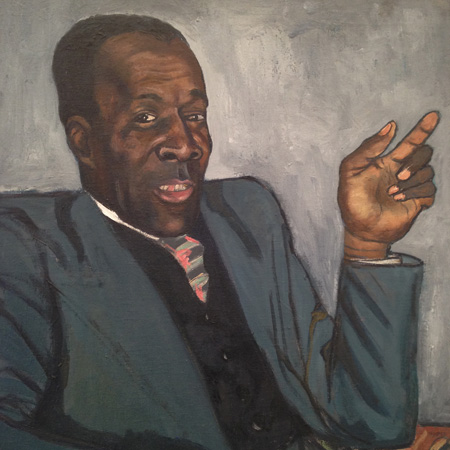 Rudolph Christian, 1951, close-up image courtesy of Arteidolia
Rudolph Christian, 1951, close-up image courtesy of Arteidolia
I joined the Party several times. But you know what? I’m not a bureaucrat, by nature. I hate bureaucrats. You know what I am, I’m an anarchic humanist.
Phillip Bonoksy, novelist and journalist at the Daily Worker, said of his life long friend:
Everybody was a Communist then. The art movements were very sharply influenced by Marxism, and it was right down her alley. The Marxists were the only ones who recognized her. She was not only an artist, but a woman, not only a woman but a lost woman; she was an unmarried woman and she had everything against her. But she found a home there. She found people who respected her.
The FBI categorized Neel as a “romantic Bohemian type Communist,” and there are apparently 156 highly redacted pages full of inaccuracies and trivia concerning her affiliations, associations and activities with the Communist Party. Two agents were sent to her apartment in 1955, but she, naturally, refused to cooperate. Neel instead asked them to pose for her since she didn’t have any FBI agents in her collection. Embarrassed, they left and never came back.
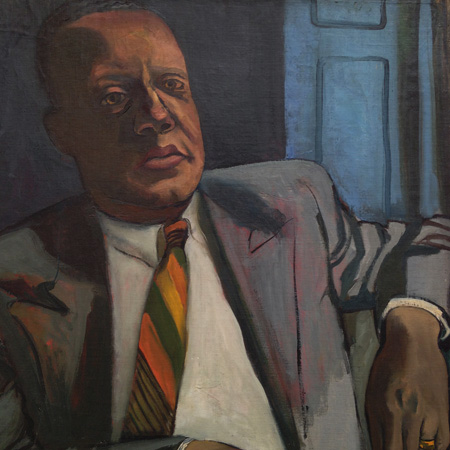 Horace Cayton, 1949, close-up image courtesy of Arteidolia
Horace Cayton, 1949, close-up image courtesy of Arteidolia
Neel moved to 10 East 107th street in 1941 with her two young sons and then to 21 East 108th, where she lived for the next 20 years. Congress terminated the WPA in 1943, leaving Neel to depend on welfare.
The emergence of Abstract Expression did not divert her at all as she’d always resisted doing whatever was being considered “in fashion.” In a review of a 1951 group exhibition at A.C.A. Gallery, Mike Gold quoted Neel in the Daily Worker:
There isn’t much good portrait painting being done today, and I think it is because with all this war, commercialism and fascism, human beings have been steadily marked down in value, despised, rejected and degraded.
Her building was sold in 1962. The new owner planned to subdivide and double the rents. Neel was the last to go. As she tells it, “They got me out by letting all the bums from the corner in and set fires to the building every night. I could see myself and all my work burning up, so I moved to the westside.”
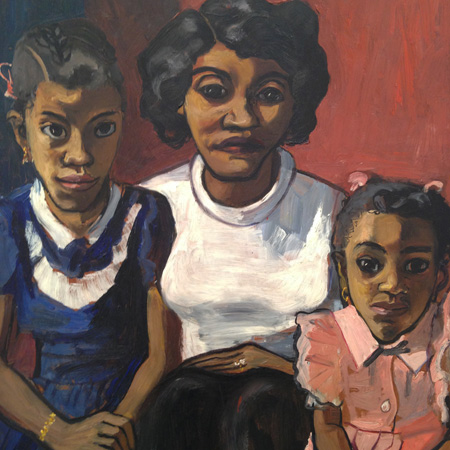 Black Spanish-American Family, 1950, close-up courtesy of Arteidolia
Black Spanish-American Family, 1950, close-up courtesy of Arteidolia
I found myself returning to a showcase in the exhibition to reread Neel’s poems and a draft of a letter to Fidel Castro.
Undated Poem:
I love you Harlem
Your life your pregnant
Women your relief lines
Outside the bank, full
Of women who no dress
In Saks 5th Ave would
Fit, teeth missing, weary,
Out of shape, little black
Arms around their necks
Clinging to their skirts
All the wear and worry
Of struggles on their faces
What a treasure of goodness
And life shambles
Thru the streets,
Abandoned, despised,
Charged the most, given
The worst
I love you for electing
Marcantonio, and him
For being what he is
And for the rich deep vein
Of human feeling buried
Under your fire engines
Your poverty and your loves
Undated Poem:
The old cars stand on a hill and her black heart broke
and blood ran all black over the road
Our wheels made a track
Daniel Boone, the deerslayer
The white picket fences
Ku Klux Klan, soft coal
A monster standing turns into a bush
Oh baby let me kiss the shine
From off your lips
Oh darling don’t smash or crash of splinter
Let’s drive a long slow time & kiss each other
Undated letter (c. 1962):
Dear President Castro,
I have wanted for years to do a portrait of your for your government to give to the people of Cuba. My experience, my political allegiances as well as my work as a painter have been influenced by the same forces as those which brought about the Cuban revolution.
In addition to a portrait in oil, I would like to do a popular lithograph or serigraph to be sold throughout the world to be used as a fund-raiser for work by groups which support the Cuban people’s revolution.
I have done a poster for the Olympics which has been sold worldwide, and I have done a poster of you for a local demonstration. Of course, it had to be doe by imagination – what a great improvement if I could do it from life.
I understand that there is a cultural tour of Cuba beginning Dec. 29. Could this be arranged in connection with the trip, or, if not, at another early date?
I paint a great deal, but the social commentary in my work restricts sale and income. I would be grateful for your government’s help in expenses connected with travel.
With my deepest respect and warm feelings of comradeship.
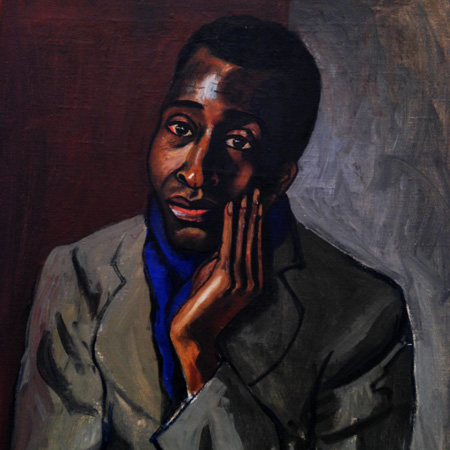 Harold Cruse, c. 1950, close-up image courtesy of Arteidolia
Harold Cruse, c. 1950, close-up image courtesy of Arteidolia
In another showcase was a photograph of a picket in front of the Metropolitan Museum of Art against its 1969 exhibition Harlem on My Mind: Cultural Capital of Black America 1900-1968. Instead of exhibiting painting & sculpture by black artists, the MET had staged a science museum style “multi-media extravaganza” about day to day life in Harlem with floor to ceiling photo murals, projections, recorded sounds and a live, closed-circuit TV view of 7th Avenue at 125th Street. The artist-activist group, Black Emergency Cultural Coalition (BECC) came together, determined to transform action into agency against cultural racism in art institutions. The Coalition charged that the MET’s characterization of Harlem cultural life was “full of distortions and misrepresentations” and demanded that it be “closed down.”
Another photograph showed Neel holding a sign reading, DOTY IS A FOUR LETTER WORD during the BECC’s protest of the Whitney Museum’s 1971 survey show, Contemporary Black Artists in America. This exhibition was to be the museum’s response to criticisms of The 1930s: Painting and Sculpture in America, a 1968 show that had completely bypassed the contributions of black artists. The BECC had countered by organizing Invisible Americans: Black Art of the 30s at the Studio Museum of Harlem. They entered into negotiations with the Whitney demanding full representation in exhibitions & collections as well as a black curatorial staff. Despite this, the museum refused to bring in a black co-curator for the 1971 show and left that task to the museum’s Robert Doty. The BECC called for a boycott by “all concerned Black Artists” and “all sympathetic members of the art community and all people concerned with cultural freedom.” Fifteen artists withdrew from the Whitney show and joined forces with the BECC in the Rebuttal to the Whitney Exhibition, at the Acts of Art Gallery, a black owned space on Charles Street. The debate as to who defines and selects black artists and to where the work is publicly shown remains loud and clear.
Below these photographs was an unlabeled drawing of angered faces and raised fists that Neel had done for The Attica Book, published by BECC and Artists and Writers Protest Against the War in Vietnam, which, along with art, featured poetry by inmates from prison writing projects. To voice disgust with both MoMA’s refusal to sell the book and Governor Nelson Rockefeller’s handling of the 1971 prison strike, which had led to 43 deaths, a protest was held in front of the museum. Neel’s sign reads ATTICA: ROCKEFELLER CALL THE SHOTS.
Phillip Bonosky, while finishing up as Moscow correspondent for the Daily Worker, helped to organize a 1981 retrospective at the Moscow Artists’ Union for Alice Neel. She was the first living American artist to show in the Soviet Union, something she had always dreamed of. “My idea was that anything that stimulates détente makes the danger of nuclear war less. That’s why I wanted to go.”
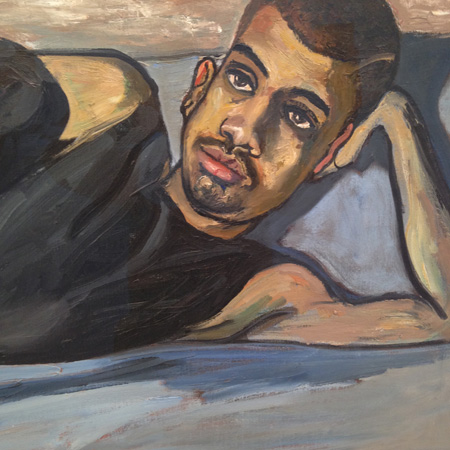 Ballet Dancer, 1950, close-up image courtesy of Arteidolia
Ballet Dancer, 1950, close-up image courtesy of Arteidolia
She was always reaching out to try to do something about what she saw as the inhumanity of man…she was trying to stand for something that was better than what was. You know she felt that there was so much injustice in a broad way. It’s almost saying she couldn’t achieve what she wanted; there was almost no way to do that,because it was so big. And I just think that we are so lucky that she was able to get it out in paint.
– Benny Andrews, co-founder of the BECC

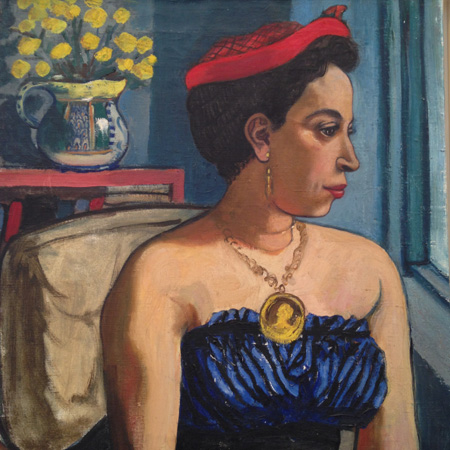 Alice Childress, 1950, close-up image courtesy of Arteidolia
Alice Childress, 1950, close-up image courtesy of Arteidolia
Excellent!
You capture the core of Neels socialist soul. This exhibition is the real Alice Neel. By publishing her poems and letter to Fidel you present the drama of her life, a life that was unique and dedicated to recording the people she wanted to be with.